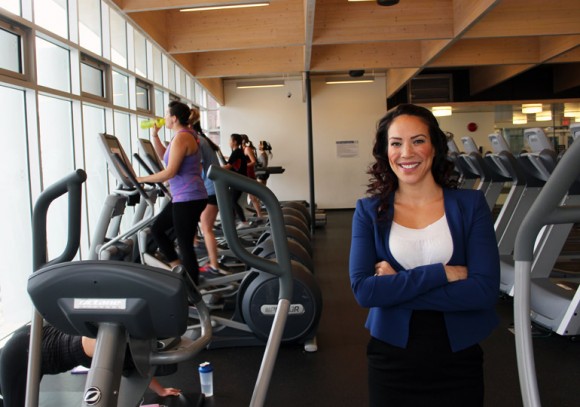
Mary Jung, assistant professor with the School of Health and Exercise Sciences.
UBC prof. provides five tactics for sticking with a healthy exercise routine
How are those resolutions working out for you? Research shows that by a few weeks into January, most people who made resolutions at the New Year have already given up.
If your resolution to hit the gym more frequently lasted barely a week, don’t worry—you’re not alone.
The good news is that Mary Jung, an assistant professor with UBC Okanagan’s School of Health and Exercise Sciences, is finding results to help people stick with their exercise routine. The findings in Jung’s recently published research project, Where Does HIT Fit? could be just what the doctor ordered for a global health market pushing $30 billion a year.
HIT—short for high-intensity training—involves short bursts of activity with periods of rest. It has been touted as a time-efficient, novel alternative to conventional no-pain-no-gain exercise. Jung was intrigued to know how people actually respond to HIT psychologically, and whether people would actually do it when not under the guise of a research study.
“Several exercise physiologists were conducting studies and demonstrating how effective HIT was at improving fitness,” she says. “After seeing such promising results, I wanted to see whether it was an attractive long-term exercise option—and whether or not people enjoyed it.”
Jung has several research projects on the go, all related to exercise or sticking to that exercise routine. Last year, she was awarded a $450,000 five-year Michael Smith Foundation for Health Research Scholar Award that will contribute to her work into social cognitive theory.
“We know that exercise is good for us, but many still do not do it because we prefer immediate gratification such as sitting down and watching TV, or we fear that we may not be able to do it,” Jung says.
Jung is using social cognitive theory as part of her research to develop and test novel, feasible, and translatable self-regulatory training techniques. Her theory is that brief social interventions will provide a practical and feasible means to bolster self-regulatory skills necessary for long-term adherence to physical activity.
Rather than just telling people to start exercising, Jung teaches them how to self-regulate exercise so that they can exercise on their own for years to come. Participants learn key self-regulatory skills, including bolstering self-confidence to overcome barriers, goal-setting, and learning how to self-monitor their progress.
So far, the results are promising. Current research participant Beth Jardine feels like she has a new lease on life. She was no stranger to the common barriers to exercising, having given up several well-intentioned attempts to exercise regularly.
“I am proud of myself,” Jardine says, having continued with the program since starting four months ago.
Jung says her great reward is seeing participants’ success as “independent exercisers.”
“We get to say, ‘You did that all on your own!’ Believing in yourself and your capabilities is more influential than any barrier placed in your way.”
To learn more about Jung and her research, visit ourstories.ok.ubc.ca/maryj.
TOP FIVE TACTICS FOR STICKING WITH IT
Asst. Prof. Mary Jung breaks down her research into her top five tactics for adhering to exercise.
Reward yourself for every step you make towards achieving your long-term goal
“Rewards motivate you and reinforce goal-related behaviour in the short-term,” Jung says. Rewards promote consistency, which Jung identifies as key to success for adhering to health behaviours.
Avoid comparisons
Jung shares how comparisons can be demotivating; they devalue what you accomplish. “Focus on being the best you rather than looking like someone or fitting into a particular size,” she says. “If we rely on inaccurate misperceptions, we can’t appreciate our own progress.”
Be kind to yourself
“Please, please be self-compassionate,” Jung says. “Self-loathing will lead you directly to giving up.”
Jung adds it also leads to unnecessary stress and anxiety. There will be setbacks—you will need a day off here and there, and that is to be expected. Jung knows this is harder than it sounds, but recommends keeping track of both successes and failures because it can help you identify patterns and remove obstacles.
Exercise in the morning
Jung says research from her lab has demonstrated that plans to exercise in the morning are much more likely to lead to exercise than plans made in the afternoon. “Your self-regulatory reserve is highest in the morning, and it is much less likely that barriers will pop up on you at 6 am!”
Believe in yourself
It might sound trite but Jung assures that you can stick to your new exercise plan: “If you think you can, you can.” Research shows you are more likely to persist through challenges, she says. “You will give more effort, you will set loftier goals, and most importantly you’re most likely to carry out those plans if you stop doubting yourself and start thinking ‘yes I can.’”
—30—